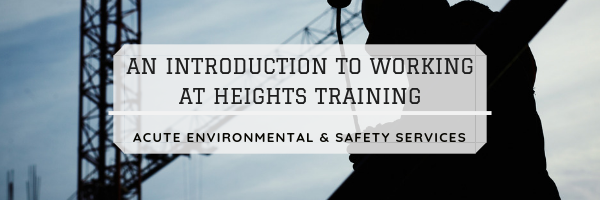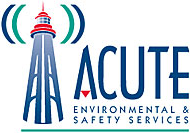Learn more about working at heights training below! Receive the most comprehensive working at heights training from ACUTE Environmental Services. Contact us today.

An Introduction to Working at Heights Training
How to Determine If You Need It
Ontario workplaces are divided into sectors under the Occupational Health and Safety act: Industrial establishments, mines and mining plants, and health care and residential facilities, and construction projects. Each is governed by specific regulations that outline training requirements.
Ontario Regulation 213/91 – Construction Projects governs construction work, and states Working at Heights training is mandatory if you are a construction project worker and if you will use any of the following:
- Travel restraint system
- Fall restricting system
- Fall arrest system
- Safety net
- Work belt OR safety belt
For more on training required for construction workers, click here.
If a hazard is imminent and your employees aren’t trained, a stop work order could be issued. As a non-compliant employer, you could could also be prosecuted under the Provincial Offences Act.
Note: You will need to take a refresher withing three years of this course to maintain your certification.

Working at heights training is required for construction workers who will be at risk of falls on the job.
What You Will Learn
The purpose of Working At Heights training program includes four parts:
- Strengthen workplace safety culture – By elevating the profile and importance of preventing falls from heights.
- Knowledge and Safety Practices – Provide workers who may be exposed to the hazard of falling with adequate knowledge about fall hazards and general safety practices to work safely at heights.
- Purpose and Use of Equipment – Provide workers who use personal fall protection equipment with sufficient knowledge about its purpose and use; and,
- Incident Reduction – Reduce the number of fall-from-heights incidents, injuries, and fatalities.
To that end, ACUTE’s Working at Heights training provides theory and hands-on practical training, as well as evaluation facilitated by highly skilled and competent instructors. Here’s a look at how the day would break down:
Working at Heights (Theory Module 3hr)
- Working at Heights (WAH) and legislation
- WAH hazards
- Safe Work Plans & assessing and controlling WAH hazards
- The hierarchy of controls – application to WAH
- Fall prevention strategies and systems
- Fall protection systems
- Ladder safety
- Written evaluation
Working at Heights (Practical Module – 3.5hr)
- Fall prevention/protection system requirements and limitations
- A-B-C component selection, inspection, use
- Harness inspection and fitting exercise & evaluation
- Lanyard inspection exercise and evaluation
- Travel restraint, fall arrest set-up exercise & evaluation
- 100% tie-off exercise and evaluation
- Ladders, scaffolds, and elevating work platforms
- Rescue plan – components and purpose
- Safe work strategies and safe anchor exercise
- Written evaluation
Check out this video for a quick preview of the course:
Working at Heights Alternatives for Non-Construction Workers
If you will be working at heights in a sector other than construction, consider the following:
This training course is geared towards those working at heights in Industrial Establishments, Mining Operations, Health Care and Residential Facilities sectors, or workplaces other than Construction Projects. This flexible training course can be modified to best suit your specific industry’s needs, and to address workplace-specific equipment. This course includes hands-on training, detailed videos, handouts, quizzes, and classroom interaction with experienced instructors.
This course focuses on the dangers of working at heights from a scaffold or ladder, and how to prevent accidents and incidents. Our Scaffolding and Ladder course teaches participants how to work safely, including how to properly dismantle scaffolding after use. Participants will learn how to properly identify workplace hazards related to scaffolding and ladders, how to identify safe scaffold setups, how to identify different types of ladders, and understand relevant legislation.

If you’re not in construction, there are alternatives to keep you safe at heights.
Trust ACUTE for Your Working at Heights Training!
With ACUTE, you will experience the best comprehensive, hands-on Working At Heights training.
ACUTE goes beyond government compliance in Ontario health and safety training.
- Open Door Instructor-Student Partnersh
 ip: ACUTE’s training services emphasize client participation. Staff foster relationships with clients and serve as a touchstone for advice moving forward.
ip: ACUTE’s training services emphasize client participation. Staff foster relationships with clients and serve as a touchstone for advice moving forward. - Serving Your Team and Industry: With a vast array of clients in the manufacturing, construction, health, academic, and government sectors, ACUTE brings the best safety practices from across the spectrum to your workplace.
- 100 Years Combined Experience: ACUTE provides comprehensive health and safety training, on-site safety services, and consulting services. With over 100 years of combined experience, our staff offers more than theoretical or abstract ideas. ACUTE offers solutions.
- Track Record of Success: ACUTE is rated 4.9/5 stars on Google reviews, demonstrating a commitment to our clients, quality, and a passion for training.
“Working with ACUTE is a seamless process. They are very helpful and accommodating with all types of training requests.” – Cheryl
Contact us today for quality training in your workplace or on-site at ACUTE’s proven training facilities, and click the button below to sign up!


